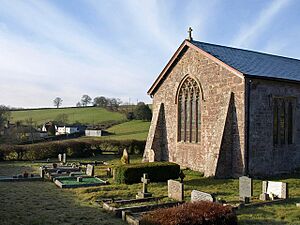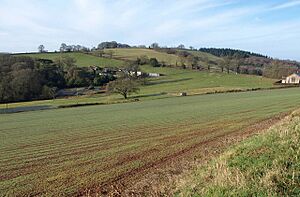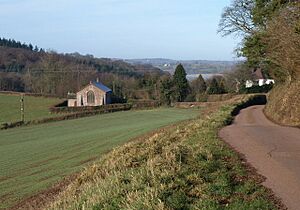Posbury facts for kids
Posbury is a very old place in Devon, England. Today, it is a small village or hamlet. It is located about 2 miles (3.2 km) southwest of Crediton and 2 miles (3.2 km) north of Tedburn St Mary. It's also about 1 mile (1.6 km) west of another small hamlet called Venny Tedburn.
Contents
Exploring Posbury Hill Fort
Posbury Hill Fort is an ancient fort from the Iron Age. It is located about three miles southwest of Crediton, Devon. This fort has not been dug up or studied much by archaeologists yet. Today, you can see parts of its old earth walls that once surrounded a hilltop. This hilltop is 180 metres (about 590 feet) above sea level.
A modern road now cuts across the northern part of the hilltop. South of the hamlet, you can find traces of an early Roman road. This road once ran from a Roman fort near Colebrooke, Devon, heading east towards Crediton.
A historian named W. G. Hoskins believed that Posbury Hill Fort might be the site of a battle called Posentesburg. This battle happened in 661 AD. During this battle, Cenwalh of Wessex, who was the King of Wessex, pushed the native Briton tribes away from central Devon towards the coast. Today, the best way to see the old defences of the hill fort is from the bridle path, which is just north of the convent.
History of Posbury Manor
The area of Posbury was once a manor, which means it was a large estate with a lord in charge. The first records show that the de Posbury family owned it. When this family had no more sons to inherit, a daughter named Eleanor de Posbury became the only heir. She married into the Pollard family, and so the manor of Posbury became theirs. The Pollards were from a place called Way, in St Giles in the Wood, Devon.
Later, in 1581, a man named John Bremridge paid respect and service to George Pollard. George Pollard was the Lord of the Manor of Posbury-Bradleigh at that time. This payment helped John Bremridge get back his family land, called Bremridge, in the parish of Sandford, Devon. Records from 1599 show that John Bremridge owned a large house and land, including orchards and gardens. This land was part of the Manor of Posbury Bradleigh.
This branch of the Pollard family was also connected to Langley, Yarnscombe, Devon. A famous lawyer named Sir John Heale (who died in 1608) was also involved with the manor. He was a judge and a Member of Parliament for Exeter.
Posbury House: A Historic Home
Posbury House was the main building in the Posbury area for a long time. It belonged to the Tuckfield family. Their early home might have been here, or at nearby Venny Tedburn or Tedburn St Mary.
John Tuckfield (who lived around 1550) was a very rich wool merchant from Exeter. He even served as the Mayor of Exeter from 1549 to 1550. His son, also named John Tuckfield (1555-1630), bought another estate called Little Fulford. This estate was later renamed Shobrooke House. It was about 4 miles (6.4 km) northeast of Posbury. The Tuckfield family then made Shobrooke House their main home.
In 1797, a writer named Rev. John Swete visited Little Fulford. He wrote in his journal that the Tuckfield family's "large woollen manufactory" (a place where wool was made into cloth) had been important in the area ever since.
Richard Hippisley (1774-1844) was a distant cousin who later took the name Tuckfield. He inherited the Tuckfield family's lands. He not only rebuilt Shobrooke House in a new style but also built St Luke's Chapel at Posbury in 1835.
St Francis's Convent at Posbury House
In 2014, Posbury House became home to an Anglican Franciscan nunnery. This means it is a place where Anglican nuns live and pray. The group is called The Community of the Franciscan Servants of Jesus & Mary. It was started in Stepney, London, in 1935 by Grace Emily Costin. She was known as "Mother Teresa."
The community moved to the Isle of Wight in 1937. Then, in 1942, they moved again to Posbury House. This move was to escape the danger of bombing during World War II. They renamed Posbury House The House of St Francis. During the war, the nuns started to host retreats for people training to become priests for the Diocese of Exeter. This practice continued until shortly before 2014. The house has its own chapel for worship. By 2014, the number of nuns in the community had become smaller. The nuns also stopped working in the local community on spiritual matters.
St Luke's Chapel: A Place of Worship
St Luke's Chapel was built in 1835 by Richard Hippisley Tuckfield. He lived at Shobrooke House. He built the chapel because the nearby Holy Cross Church, Crediton, was becoming too small. The town of Crediton was growing, and there were too many people for the church to hold.
The leaders of Crediton Church asked for legal advice to see if they could build a second church. A law passed during the time of King William IV (1830-1837) made it easier to build new churches in busy areas. The law had some rules. The old church had to have a certain number of people. The new church had to be at least two miles away from the old one. Also, at least 300 people had to live within one mile of the new church. Finally, money had to be set aside to pay for the new church's upkeep.
Rev. Samuel Rowe, who was the rector of Crediton Church, said that 700 to 800 people attended his Sunday services. So, all the rules were met. The new chapel, named after St Luke, was built at Posbury in 1836. It was on land owned by Mr. Tuckfield.
Mr. Tuckfield set up a fund of £1,000, plus extra money for building costs, to maintain the chapel. The land, the chapel building, and the money were given to a group of trustees. These trustees were important local people, including Sir Stafford Northcote, 7th Baronet, Sir Humphrey Davie, 10th Baronet, James Wentworth Buller, and John Sillifant.
The chapel was officially opened and blessed on October 18, 1836, by Henry Phillpotts, who was the Bishop of Exeter. After this, the land and building were given back to Mr. Tuckfield. Only the maintenance fund stayed with the trustees. Mr. Tuckfield became the owner of the advowson, which meant he could choose the priest for the chapel. Today, his descendant, Sir John Richard Shelley, 11th Baronet, still holds this right. The first priest appointed was Reverend Sir Frederic Shelley, 8th Baronet.
Posbury School: Education for All
Around the same time that Richard Hippisley Tuckfield built St Luke's Chapel, his wife, Charlotte Mordaunt (1777-1848), built a small school. It was located in the lane opposite the chapel. Charlotte was very keen on helping deaf and mute people, and also on training teachers for poor children. This was noted by Sir Thomas Dyke Acland, 11th Baronet, who was a pioneer in education.
Charlotte became interested in teaching the deaf and mute after visiting a friend. She met a deaf and mute girl there, which made her want to help. She traveled to Paris to learn teaching methods at a special school for the deaf and mute. When she returned home, she found two children who were deaf and mute and taught them herself.
Her teaching methods were successful. She helped to set up a school in Alphington Road, Exeter. This school was the beginning of the present Royal West of England School for the Deaf. Charlotte also wrote articles that were later published in a book called "Education for the People."
In 1838, Sir Thomas Acland started the Exeter Diocesan Education Committee. This was the first of its kind in Great Britain. By 1840, this committee had opened St Luke's Teachers' Training College in Exeter. Because of these new educational efforts, there was less need for Posbury School. It closed down and was used as a Sunday School for a while. In the 1920s, the school building was only used for storage. It was then taken down, and its stones were used to build supports for the walls of St Luke's Chapel.





